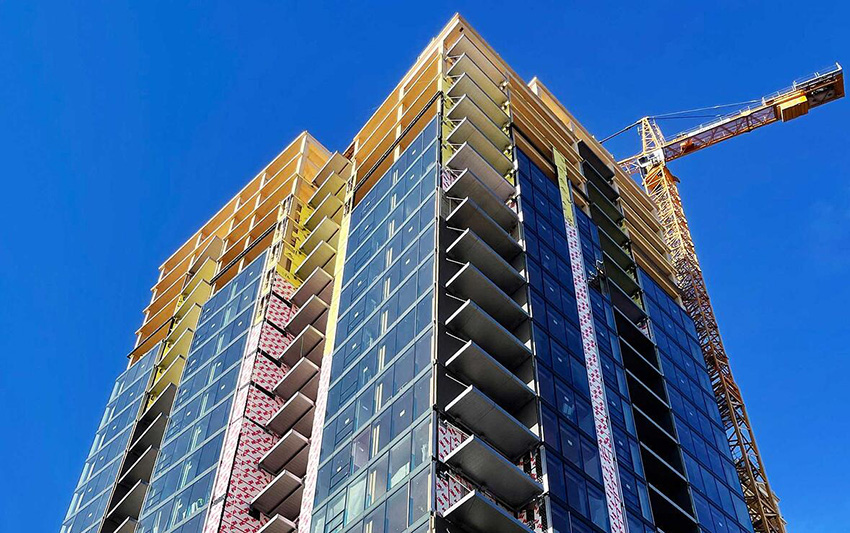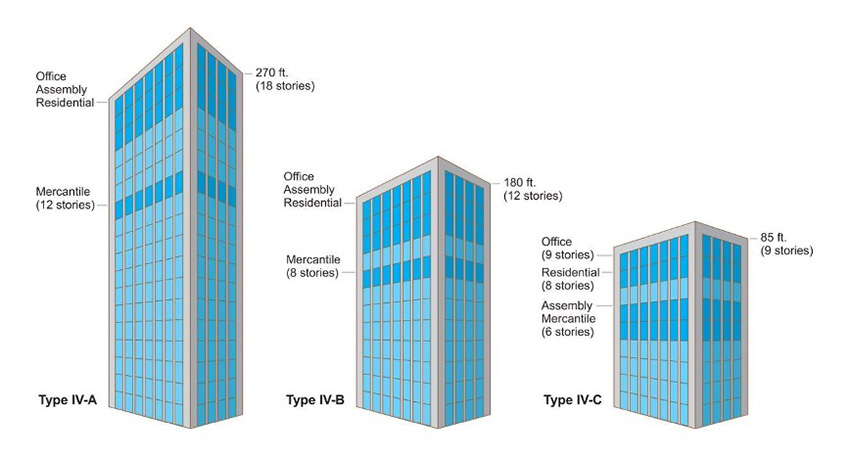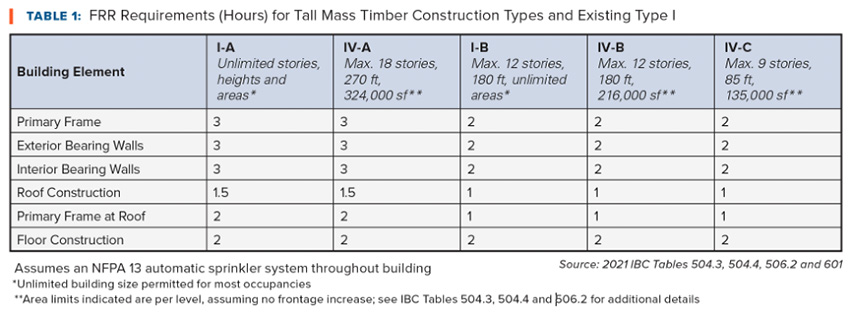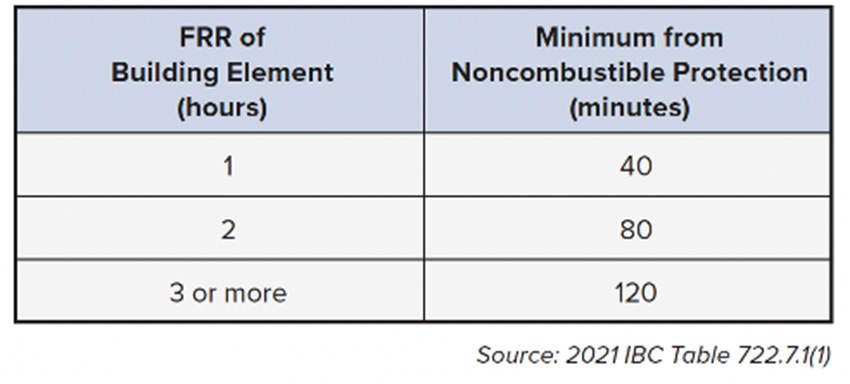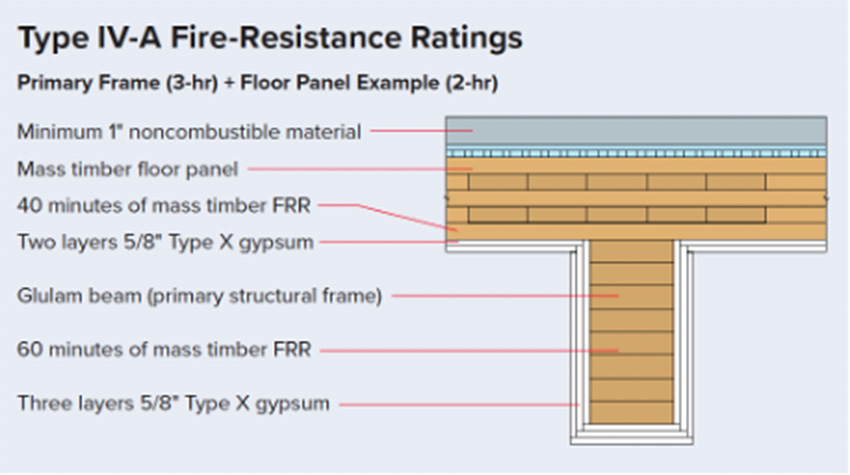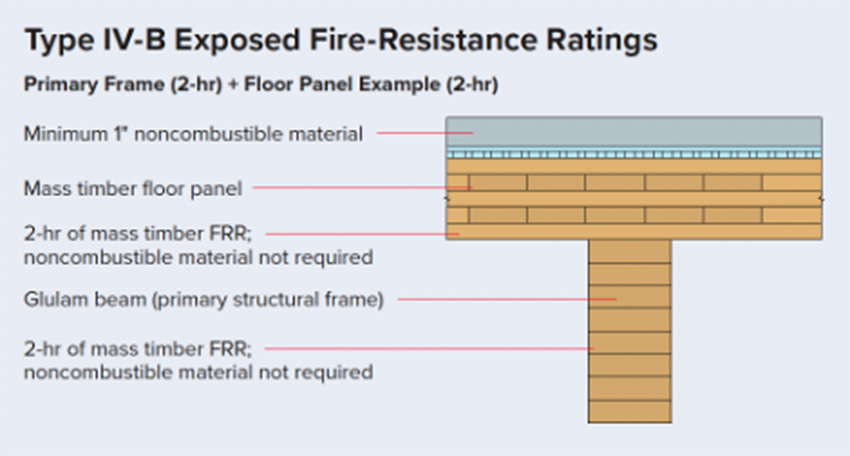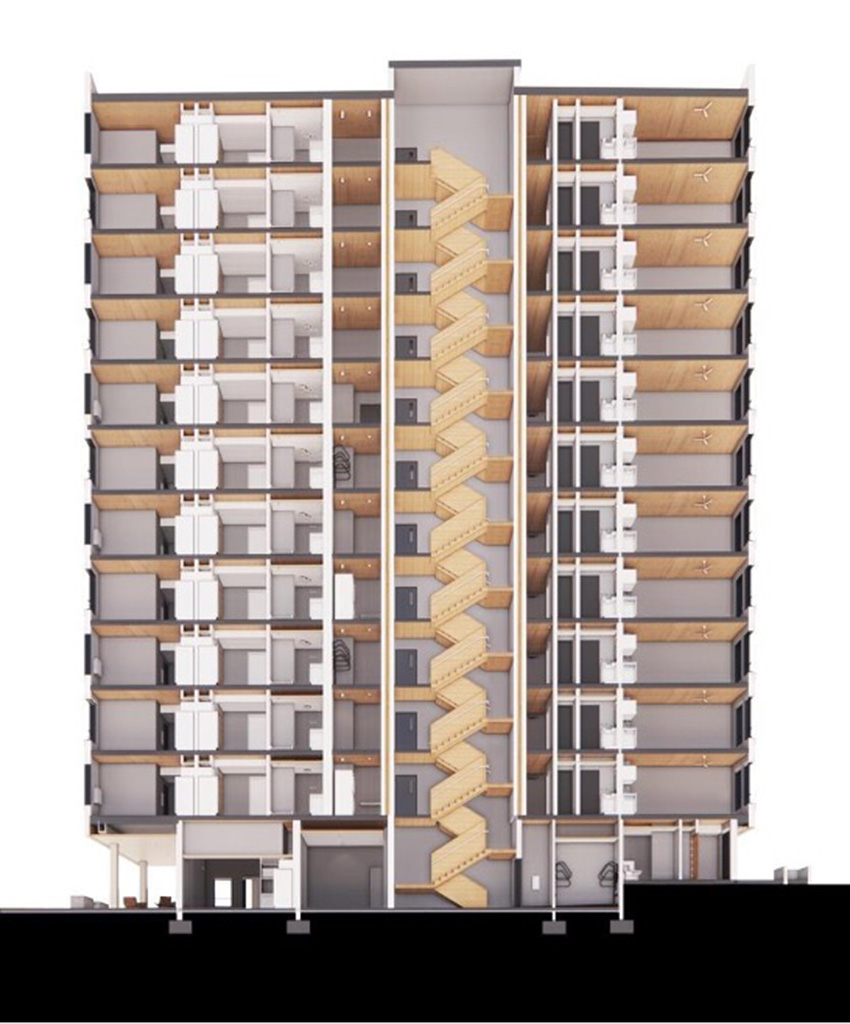TRENDS FOR INCREASED DENSITY IN LIGHT WOOD-FRAME
Although not specific to a change within the 2021 IBC, the past several years have continued to see an increasing trend of light wood-frame projects using innovative approaches to achieve greater density, site utilization, and value. Several examples of how this has been done include more incorporation of amenity spaces (roof decks, fitness centers, retail) as well as on-site parking, all located within the same building. Below is a discussion of the code provisions and design methodologies implemented to achieve these innovative projects.
For years, the IBC has allowed light wood-frame buildings up to five stories for residential occupancies (and six stories for office use) over a single-level podium. The 2015 IBC evolved to recognize multi-level podiums, which had been permitted in the Seattle Building Code for some time. Across the country, designers began maximizing the value of their midrise projects with 5-over-2 and 5-over-3 configurations; however, for one Sacramento project called 1430 Q, 5-over-2 still wasn’t sufficient to make the investment in pencil out. Sacramento’s competitive building market required that 1430 Q have at least six floors of wood-frame residential units to make the project profitable, in a 6-over-2 configuration. By using the City’s Alternate Means and Materials Request (AMMR) process, the design team was able to successfully achieve the extra height and, in so doing, build the country’s tallest light wood-frame building. Several additional projects in Sacramento, which are currently under construction, have been permitted and are using a similar 6-over-2 approach.
In Washington, six stories of Type IIIA construction are permitted when certain criteria are met. Two example projects which are leveraging these code allowances are called Analog and Moraine, both of which are located in Tacoma.
Ascent - Mass Timber Reaches New Heights in Milwaukee

Photos courtesy of Korb & Associates, New Land Enterprises (left); New Land Enterprises, LCP 360 (right)
This Milwaukee-based mass timber residential tower reaches a record-setting 25-story height and exposes more timber through the use of fire testing while also realizing faster construction time with the extensive use of BIM and numerical coding.
Location: Milwaukee, Wisconsin
Size: 493,000 square feet
Architect: Korb + Associates Architects
Developer: New Land Enterprises LLP & Wiechmann Enterprises
Structural Engineer/Mass Timber Design Program: Thornton Tomasetti
Contractors: C.D. Smith Construction (lead builder) and Catalyst Construction
At 25 stories, Ascent is a record-setting height for hybrid wood construction and is considered the tallest timber tower in the world at the time of its completion. The 493,000-square-foot mixed-use building in Milwaukee’s East Town neighborhood includes 259 apartments, a wellness and fitness center, and a top-floor amenity level. Extensive use of BIM and numerical coding of every mass timber component helped to speed up construction. According to the project’s general contractor, a conventional concrete and steel structure of this kind would typically take eight days per floor to complete—but with mass timber, the project team completed a new floor every five to six days. Due to its expansive use of wood, Ascent represents a carbon benefit equal to removing 2,350 cars from the road for one year.36
Nineteen residential stories are constructed from mass timber above a five-story concrete parking garage. A system of glulam beams and columns supports 5-ply CLT floors while two concrete cores provide lateral stability.
To reach its planned height and expose the mass timber structure allowed by code (50%), the City of Milwaukee required the project team to demonstrate that Ascent could meet the rigorous fire safety standards of a Type I building. Subsequent fire testing proved that the timber structural members not only met, but exceeded, fire rating requirements, clearing the pathway to approvals.37
Incorporating Parking in Light Wood-Frame Mid-Rise
A common configuration in multistory, multifamily wood-frame construction is parking on the first level(s) with three to five stories of wood-frame residential on top. Many designers assume that the parking level is required to be noncombustible and utilize the podium provisions within IBC 510.2; however, there are several opportunities for alternate provisions and/or wood framing within the parking levels that can offer significant cost savings.
Section 406 provides several provisions specific to motor vehicle-related occupancies. Section 406.5 provides requirements for open parking garages. The natural ventilation requirements for a garage to qualify as open are discussed in Section 406.5.2 and generally require openings on at least 40% of the garage’s perimeter, with some exceptions specified. Section 406.5.1 permits open parking garages to be of Types I, II, or IV construction.
Enclosed parking garages are covered by Section 406.6 and require both mechanical ventilation and NFPA 13 sprinklers, per Section 903.2.10. There are no limitations on construction type for enclosed parking garages, indicating that parking garages of Types III, IV or V construction can be used and framed with wood, concrete, steel and all other materials as permitted for each of these types of construction per the IBC Section 602 definitions.
Occupancy separation is a cost-effective design option frequently overlooked when a parking garage is classified as enclosed. This design route utilizes a single construction type for the entire building (i.e., the Type I-A podium of Section 510.2 is not necessary). The parking garage can still be framed with concrete or steel, for example, but there is no code requirement to use Types I or II simply due to the presence of noncombustible materials.
In a building that has an NFPA 13 sprinkler system throughout, only a 1-hour rating is required when separating parking from occupancies such as Group B, M, and R, per Table 508.4. This indicates that a mixed-use building consisting of an enclosed parking area and other occupancies could be completely framed with wood if allowable building size calculations permit the use of Types III, IV, or V construction. Even if other materials are used in the building (perhaps as columns, beams, or walls on lower levels), there is economic value in using Section 602.1.1 to classify the entire building as the lowest construction type allowed.
Utilizing the options presented in Section 510.4 offers the ability to capitalize on an increased number of stories—similar to the horizontal separation provision of Section 510.2—by stacking a Group R building on top of a single-story Group S-2 parking garage, gaining an additional story.
The main benefit of utilizing Section 510.4 is that it provides the benefit of an additional story while not requiring the full podium provision limitations of Section 510.2 (i.e., the lowest level doesn’t have to be Type I-A with a 3-hour podium slab). Specifically, this provision allows the use of a heavy timber-framed parking level (if open) and only requires a 1-hour rating (if the parking level is Type IV) or 2-hour rating (if the parking level is Type I) to separate the parking from adjacent residential units above.
Incorporating Occupied Roof Decks in Light Wood-Frame Mid-Rise
Occupied roof decks are becoming more common in multifamily and commercial buildings as designers and owners seek to increase the marketability of their rental spaces with more amenities. In most instances, these roof decks are open-air, without roof coverings, and have partial-height guards or wall parapets around their perimeter. Designers often wonder if a roof deck of this kind needs to be included as a story when calculating the required construction type, building area, and number of stories. Language was added to the 2018 IBC stating that a roof occupied in full or in part with the same occupancy as the story immediately below does not need to be included in the building area regulated by Section 506. Further, if the building is fully equipped with an NFPA 13 or NFPA 13R sprinkler system and an occupant notification system in accordance with section 907.5, the roof occupancy is not restricted to the occupancy of the story below.
In most instances, an occupied roof deck with a roof covering or walls that are taller than 48 inches is considered a separate story and must be included in building area calculations. If considered a mezzanine or accessory occupancy (Sections 505.2 and 508.2), it may be possible to exclude the occupied roof deck (and its enclosing elements) as a separate story when determining the construction type.
Tall Timber Adds Distinction to Cleveland Locale

Photos courtesy of ImageFiction (left), courtesy Hartshorne Plunkard Architects/Harbor Bay Real Estate Advisors (right).
Just-in-time prefabricated tall wood construction speeds up assembly, while an alternate-means process boosts the amount of timber exposed in this 500,000+ square-foot Cleveland-based residential project.
Location: Cleveland, Ohio
Size: 512,000 square feet
Owner: Harbor Bay Real Estate Advisors
Architect: Hartshorne Plunkard Architecture (HPA)
Structural Engineer: Fast+Epp
Contractor: Panzica Construction
Completion: Spring 2022
When Chicago-based Harbor Bay Real Estate Advisors acquired a coveted corner lot adjacent to Cleveland, OH’s well-known West Side Market, they embraced the opportunity to honor the cultural prestige of their historic surroundings.
Partnering with design firm Hartshorne Plunkard Architecture (HPA), Harbor Bay’s 115-foot tall, 512,000-square-foot, nine-story mass timber complex provides 300 apartments—many with unobstructed lake and skyline views. The resulting mass timber structural system consists of 3,000 cubic meters of blond hem-fir and spruce trees. Eight of the nine stories, set atop a one-story concrete podium, use mass timber.
The design team considered traditional concrete and steel construction but then looked to mass timber as an opportunity to achieve project goals including aesthetics, speed of construction, and environmental performance. According to Harbor Bay, INTRO’s construction time has been about 25 percent faster than typical concrete or steel construction, which was achieved by streamlining the project’s workflow and carefully managing just-in-time delivery and trade coordination.
Nearly half of the building’s interior surfaces feature exposed structural wood, including precisely cut glulam beams and columns, as well as CLT floors and ceilings in the units’ bedrooms and living rooms. This approach was guided by an Alternatively Engineered Design report specifying how the tall wood building could safely include an exposed timber interior.
2024 IBC CODE CHANGES
While the 2021 IBC has been adopted by several jurisdictions, with others in the process of updating as discussed below, the code development cycle for updates to the 2024 IBC is now underway. Most notably with respect to tall mass timber is a proposed change to the ceiling exposure allowances for Type IV-B. Under the 2021 IBC, Type IV-B is permitted up to 20% ceiling exposure as noted. However, a planned update would allow 100% ceiling exposure in the 2024 IBC. Several projects currently in design are looking to leverage these future code allowances, and several jurisdictions are including this change in their code amendments and code adoption processes.
JURISDICTIONAL CODE ADOPTIONS
While the list is constantly changing, the following jurisdictions have adopted the tall mass timber provisions in the 2021 IBC, either in whole or with local amendments.
- Oregon
- Washington
- City of Denver
- Utah
- California
- City of Austin, Texas
- City of Bryan, Texas
- Maine
- Georgia
- Idaho
- Connecticut
- Maryland
- New Jersey
- South Carolina
- South Dakota
Several other jurisdictions are considering or are in the process of adopting the tall mass timber provisions or the 2021 IBC in whole. Note that several jurisdictions including Denver and Oregon have already adopted the tall mass timber provisions of the 2021 IBC and will be adopting the 2024 IBC allowance for 100% ceiling exposure under the 2022 Denver Building Code, scheduled to be adopted in the summer of 2022.
THE URGENT NEED TO LOWER BUILDING CARBON FOOTPRINTS
Advancements in tall wood construction and codes are being made just as the call for low-carbon construction reaches new levels of urgency. The built environment is growing at a record pace in the United States. It is estimated that 2.5 million new housing units are needed to make up for the nation’s housing shortage15.
Buildings and their construction account for 39% of global carbon dioxide emissions; 28% of those emissions come from operational carbon—the energy used to power, heat and cool a building16. Buildings’ operational carbon can be reduced through energy efficiency measures and policymakers, architects, developers, and engineers have made significant advances in this arena. The remaining 11% of carbon emissions are generated from building materials and construction17. This embodied carbon can account for half of the total carbon footprint over the lifetime of the building18.
Embodied carbon is a priority for many environmental, architecture, and urban planning organizations including C40 Cities19, Architecture 203020, Urban Land Institute21, and the World Green Building Council22. Many experts believe addressing embodied carbon for buildings and building materials is critical to achieving the goals of the Intergovernmental Panel on Climate Change (IPCC) and the 2016 Paris Climate Agreement.
80M - First Mass Timber Vertical Addition Differentiates in D.C.

Photo courtesy of Hickok Cole
A nimble, lightweight, and prefabricated mass timber structure helps make a 100,000-square-foot vertical addition possible while boosting the value of this D.C.-based commercial office complex.
Location: Washington, D.C.
Size: 100,000 square feet
Owner: Columbia Property Trust
Architect: Hickok Cole
Structural Engineer: ARUP
Contractor: Davis Construction
Completion: Spring 2022
As vacant parcels become harder to find in densifying urban centers and business districts, developers are looking at expansion through vertical additions. At a current height of 90 feet (seven stories), 80 M Street was a perfect candidate for vertical expansion, but it also needed to appear unique in the District’s crowded commercial market. To accomplish both goals, architect Hickok Cole chose mass timber for their 100,000-square-foot addition, a first of its kind for the city and the design team. Glulam forms the beams, columns, arches and trusses, while CLT forms the walls, floors and ceiling.
The design team’s decision to use mass timber was driven by a number of factors. Chief among them was timber’s light weight, as the existing building could not handle the load of a traditional concrete addition. Timber’s light weight also proved advantageous by allowing the team to deliver the project more quickly and with less impact to the occupied building.
Once completed, the addition will add two full floors of office space atop the existing 286,000-square-foot building as well as an occupied penthouse level and rooftop terrace for social space. Other design highlights include exposed CLT ceilings and an abundance of connected outdoor spaces that will add nearly 4,000 square feet of outdoor amenity space atop the building.
EMBODIED CARBON IN A BUILDING’S LIFE CYCLE
Embodied carbon is determined by conducting a life-cycle assessment (LCA) of a product, assembly, or building over declared life- cycle stages. An LCA study returns results for a number of environmental metrics, including the potential to impact climate or “global warming potential” (GWP). Embodied carbon is the GWP result. Embodied carbon is measured for each stage of the product’s life cycle, allowing comparisons across any combination of stages.
As buildings become more energy efficient, the upfront embodied carbon from materials begins to account for a higher proportion of a building’s carbon footprint23. Very soon, embodied carbon is likely to become the dominant source of building emissions.
Embodied carbon varies dramatically between concrete, steel and wood, making product decisions key in achieving lower carbon buildings. Manufacturing wood products requires less total energy, and in particular less fossil energy, than manufacturing alternative structural materials including metals, concrete, or bricks24.

STORED CARBON IN WOOD PRODUCTS
Wood products are approximately 50% carbon by dry weight25. The use of wood products in buildings provides an additional environmental benefit by storing carbon removed from the atmosphere. This ability to store carbon sequestered during tree growth in the forest makes wood an ideal product for buildings, which are designed for long service lives. Essentially, a wood building is a large carbon sink26.
Timber as a tactic for curbing climate change is backed by a growing body of research and advancements in calculating the carbon footprint of building materials27. In a recent paper published in the journal Nature Sustainability, experts at the Potsdam Institute for Climate Impact Research28 in Germany delved into four possible scenarios of timber use in buildings over the next 30 years. In the first case, “business as usual,” 0.5% of buildings are made with wood while the vast majority remain constructed of concrete and steel. There’s a 10% timber building scenario; a 50% timber building scenario; and a fourth in which the vast majority—90% of new construction—is made with wood. Their findings suggest that the lowest scenario could result in 10 million tons of carbon stored per year and in the highest, nearly 700 million tons29.
“Buildings, which are designed to stay for decades,” researchers write in the paper, “are an overlooked opportunity for a long-term storage of carbon, because most widely used construction materials such as steel and concrete hardly store any carbon."30
THE ROLE OF WOOD CONSTRUCTION NOW AND IN THE FUTURE
There is an urgent need to decarbonize the built environment, combat climate change and find advanced ways to reduce and store carbon emissions. The exigency to cut carbon is demonstrated by the environmental priorities set by such organizations as C40 Cities31, Architecture 203032, Urban Land Institute33, and the World Green Building Council34 advocating for significant changes in how we plan, build, manage, and power cities and towns—including a reduction in embodied carbon over a building’s life cycle. Wood has an increasing role to play as design professionals look to tackle the climate crisis and reduce the environmental footprint of buildings, now and in the future.
Buildings and infrastructure built from bio-based materials such as timber that store carbon during their service lives can serve as constructed carbon sinks. They could increase the existing carbon pool of urban areas (1–12 GtC) by 25 to 170%35. Backed up by testing and research, code changes in jurisdictions across the country are making it possible to increase the height and density of wood construction. With a comprehensive understanding of these code changes, design teams can bring innovation and ingenuity to the buildings they design.
ADDITIONAL RESOURCES
To help building designers compare options, WoodWorks has compiled a web-based inventory of completed mass timber fire tests. The Inventory of Fire Resistance Tested Mass Timber Assemblies & Penetrations is updated as new tests become available and can be found at www.woodworks.org.
For additional information on both the calculation-based method and the ASTM E119 testing method of demonstrating FRR of mass timber elements, see the WoodWorks publication Fire Design of Mass Timber Members.

